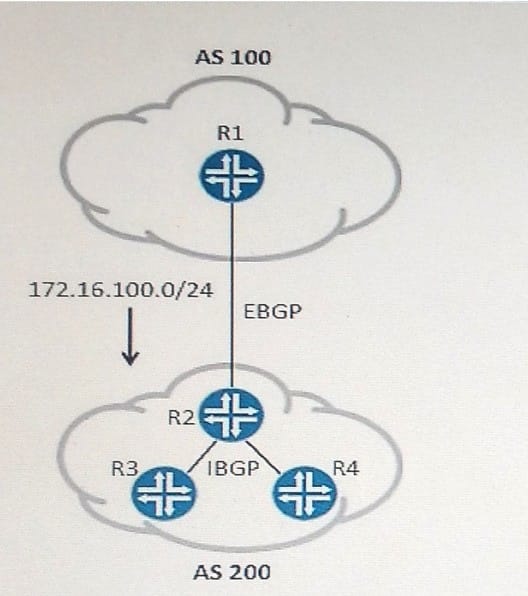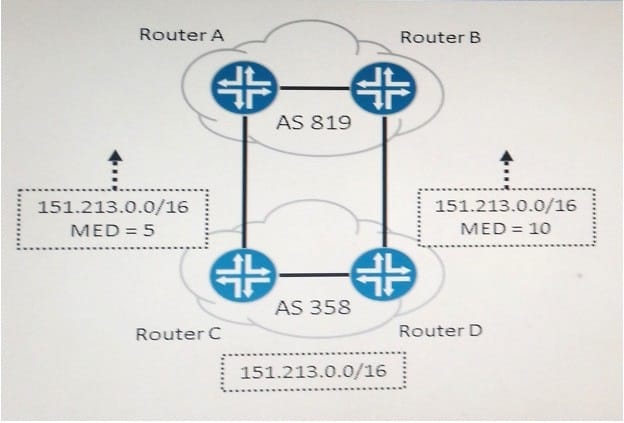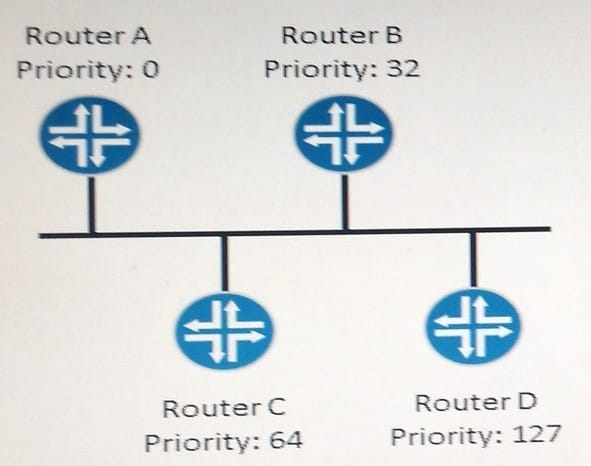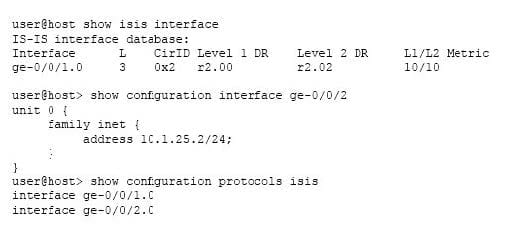Exam Details
Exam Code
:JN0-361Exam Name
:Service Provider Routing and Switching, Specialist (JNCIS-SP)Certification
:Juniper CertificationsVendor
:JuniperTotal Questions
:542 Q&AsLast Updated
:Jul 17, 2025
Juniper Juniper Certifications JN0-361 Questions & Answers
-
Question 221:
Which OSPF LSA type describes the router IDs of ASBR routers located in remote areas?
A. Type 4
B. Type 2
C. Type 3
D. Type 1
-
Question 222:
Your customer requests that you provide a transparent Layer 2 service between two of their remote locations. This service must allow the customer to pass tagged traffic from multiple VLANs. You decide to use Q-in-Q tunneling on the two provider edge MX Series routers that connect to the customer's CE devices. Which two statements are true? (Choose two.)
A. As traffic leaves the Q-in-Q tunnel, the S-VLAN tag will be removed from the frames.
B. As traffic enters the Q-in-Q tunnel, an S-VLAN tag will be added to the frames.
C. As traffic enters the Q-in-Q tunnel, a C-VLAN tag will be added to the frames.
D. As traffic leaves the Q-in-Q tunnel, the C-VLAN tag will be removed from the frames.
-
Question 223:
What is the correct format for an IPv4 address mapped into IPv6?
A. ::192:168:0:1
B. ::FFFF:192.168.0.1
C. ::FFFE:192:168:0:1
D. ::192.168.0.1:FFFF
-
Question 224:
You are deploying IS-IS in your network to enable the routing of only IPv6. Assume that the loopback interface has been properly configured.
What is the minimum required configuration to enable only IPv6 routing in IS-IS?
A. user@host# show protocols isis rib-group inet6; interface ge-0/0/0.0; interface lo0.0 { passive; } user@host# show interfaces ge-0/0/0 unit 0 { family inet6 address fd85:5944:1aee:026::1/64; }
B. user@host# show protocols isis interface ge-0/0/0.0; interface lo0.0 { passive; } user@host# show interfaces ge-0/0/0 unit 0 { family iso; family inet6 address fd85:5944:1aee:026::1/64; }
C. user@host# show protocols isis no-ipv4-routing; interface ge-0/0/0.0 interface lo0.0 { passive; } user@host# show interfaces ge-0/0/0 unit 0 { family iso; family inet6 address fd85:5944:1aee:026::1/64; }
D. user@host# show protocols isis no-ipv4-routing; interface ge-0/0/0.0; interface lo0.0 { passive; } user@host# show interfaces ge-0/0/0 unit 0 { family iso; family inet6; }
E. user@host# show protocols isis traffic-engineering { family inet6 { shortcuts; } } interface ge-0/0/0.0;
interface lo0.0 {
passive;
}
user@host# show interfaces ge-0/0/0
unit 0 {
family inet6 address fd85:5944:1aee:026::1/64;
family iso;
}
-
Question 225:
For two switches to participate in the same Multiple Spanning Tree Protocol (MSTP) region, which three values must match? (Choose three.)
A. extended system ID
B. region name
C. member VLAN ID list
D. root bridge ID
E. revision number
-
Question 226:
Click the Exhibit button.

In the exhibit, R1 is sending the 172.16.100.0/24 route to R2 through EBGP. R2 has IBGP sessions to R3 and R4, but they are not installing the route. All BGP sessions are established.
Which two actions would enable R3 and R4 to install the route from R2? (Choose 2.)
A. Advertise the R1-R2 link into the IGP.
B. Configure the cluster-id parameter under the R2 IBGP group.
C. Configure a BGP export policy with a next-hop self action on R2.
D. Configure an IGP export policy with a next-hop self action on R2.
-
Question 227:
In a Junos device functioning as an MPLS transit router, which routing table is used when performing a forwarding lookup for an incoming packet?
A. mpls.3
B. inet.0
C. inet.3
D. mpls.0
-
Question 228:
Click the Exhibit button.

Referring to the exhibit, MED is being used in your BGP network. All other BGP configurations use the default settings.
Which statement is correct regarding traffic destined to the 151.213.0.0/16 prefix in AS 358?
A. A traffic black hole will be created at Router A and Router B.
B. Traffic will load-balance across both the A-to-C and B-to-D paths.
C. Traffic will prefer the A-to-C path.
D. Traffic will prefer the B-to-D path.
-
Question 229:
Click the Exhibit button.

Referring to the exhibit, four IS-IS routers have been deployed on a multi-access Ethernet segment. Router C came online first.
After all routers are online, which two statements are true? (Choose two.)
A. Adjacencies are only formed with designated intermediate system (DIS).
B. Router D is the designated intermediate system (DIS).
C. Adjacencies are formed between all four routers.
D. Router C is the designated intermediate system (DIS).
-
Question 230:
Click the Exhibit button.

An ISO NET has been configured on R2's lo0.0 interface and ge-0/0/2.0 has been configured to run IS-IS. However, IS-IS adjacency on ge-0/0/2.0 is not coming up.
Referring to the exhibit, what is required to enable IS-IS?
A. Configure the family iso parameter under the ge-0/0/2.0 interface.
B. Disable Level 2 for interface ge-0/0/2.0
C. Add the lo0.0 interface under the [edit protocols isis] hierarchy.
D. Configure the interface priority for ge-0/0/2.0.
Related Exams:
JN0-102
Internet Associate, Junos(JNCIA-Junos)JN0-104
Junos, Associate (JNCIA-Junos)JN0-105
Junos, Associate (JNCIA-Junos)JN0-1101
Juniper Networks Certified Design Associate (JNCDA)JN0-1103
Design, Associate (JNCIA-Design)JN0-130
Juniper networks Certified internet specialist.e(jncis-e)JN0-1301
Data Center Design, Specialist (JNCDS-DC)JN0-1302
Data Center Design Specialist (JNCDS-DC)JN0-1331
Security Design, Specialist (JNCDS-SEC)JN0-1332
Security Design, Specialist (JNCDS-SEC)
Tips on How to Prepare for the Exams
Nowadays, the certification exams become more and more important and required by more and more enterprises when applying for a job. But how to prepare for the exam effectively? How to prepare for the exam in a short time with less efforts? How to get a ideal result and how to find the most reliable resources? Here on Vcedump.com, you will find all the answers. Vcedump.com provide not only Juniper exam questions, answers and explanations but also complete assistance on your exam preparation and certification application. If you are confused on your JN0-361 exam preparations and Juniper certification application, do not hesitate to visit our Vcedump.com to find your solutions here.